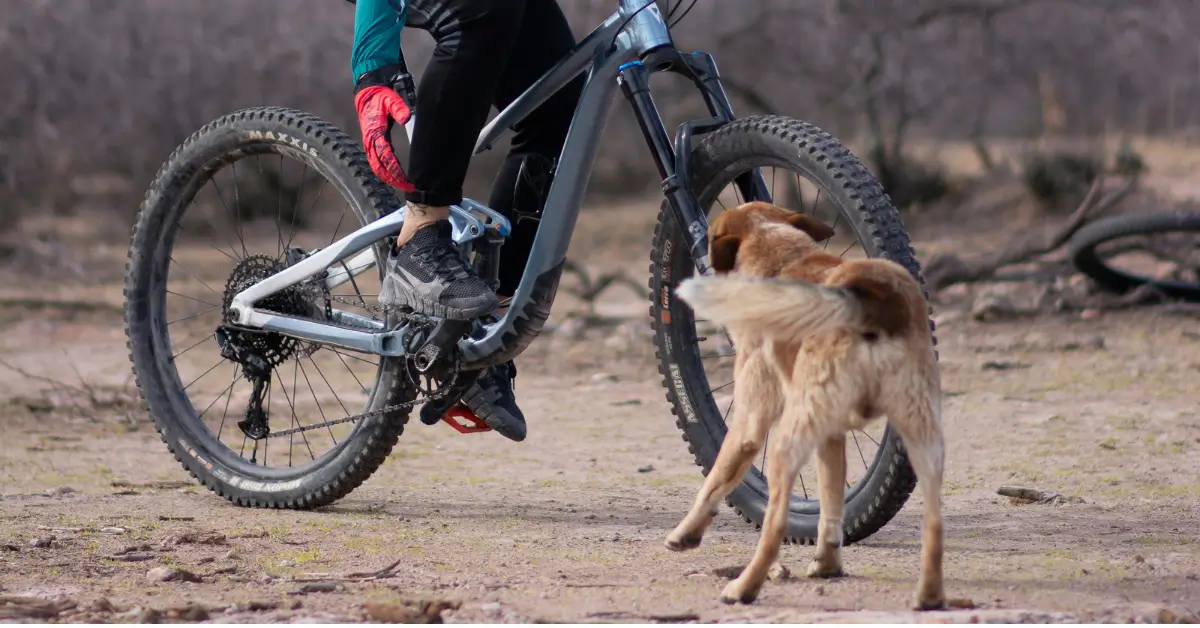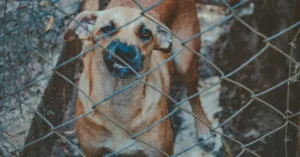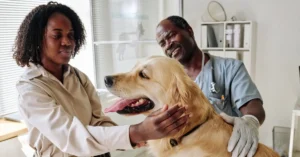Many owners feel overwhelmed and unsure how to calm their aggressive dogs down. Concern for safety and the dog’s well-being is central to effectively addressing canine aggression. This article will cover several methods to soothe an aggressive dog, delve into the causes of such behavior, and provide actionable advice to help restore peace.
Dog aggression can appear in multiple forms, including growling, biting, and snapping. It’s important to recognize these signs early to prevent harm and address the underlying issues contributing to this behavior. By understanding the triggers and effectively managing the environment, you can help mitigate aggressive tendencies in your dog.
Moreover, calming an aggressive dog often involves seeking professional advice and employing targeted training strategies. Whether you’re dealing with a guard dog who’s become too protective or a rescue dog struggling with past trauma, the right approach can make a significant difference. Let’s explore how you can help your dog become more relaxed and less aggressive, ensuring a safer environment for everyone involved.
Recognizing the Signs That Your Dog May Become Aggressive
It’s important to recognize early signs of aggression in dogs, such as growling, snarling, showing teeth, and rigid body postures. These signs can indicate protective aggression or predatory behavior, often triggered in tense situations where the dog needs to defend its space or resources.
Spotting these signs early allows for timely interventions that can prevent escalation. Veterinary professionals recommend tools like muzzles to manage these behaviors safely, especially around children or other pets, helping to create a safer environment for everyone involved.
Exploring the Common Causes of Aggressive Behavior in Dogs
Understanding the causes of canine aggression, such as pain or psychological stress, is crucial for preventing and managing these behaviors. Aggression can manifest in reactions to perceived threats, often shown through growling or snapping, particularly under stress or when a dog feels its space is invaded. Recognizing early signs like bared teeth or glaring eyes is important for preventing aggressive responses, especially toward children.
Managing these behaviors involves soothing techniques like providing calm spaces or using muzzles to ensure safety and avoid injuries from bites. This knowledge enables owners to effectively handle their pets in various situations, promoting peaceful coexistence between dogs and people.
The Role of Pain in Aggressive Behavior
Pain can often trigger aggressive behavior in dogs. If a dog is hurting, it might become aggressive to avoid further discomfort or to protect itself from the touch that exacerbates the pain. Common signs that a dog is in pain include excessive licking of a particular area, difficulty settling down, and a sudden change in behavior.
Conditions such as arthritis, dental issues, or internal injuries can result in considerable discomfort and may trigger aggression. It’s vital to seek veterinary care to diagnose and treat any hidden medical conditions that might be causing your dog pain. Prompt and effective treatment not only helps alleviate the pain but can also reduce the aggressive responses associated with it.
Fear, Anxiety, and Socialization Challenges
Fear and anxiety are potent triggers for aggression in dogs. A threatened or fearful dog might react aggressively as a defense mechanism. This type of aggression can often be linked to inadequate socialization. Dogs that aren’t regularly exposed to various people, animals, and environments from a young age may feel more anxious or threatened in unfamiliar situations.
To prevent this, it’s crucial to begin socialization early. Introduce your dog calmly to new experiences and continue this exposure throughout life. Training focusing on positive reinforcement can also help your dog learn to cope with anxiety-inducing situations more effectively, reducing their need to respond aggressively.
Effective Tips to Calm an Aggressive Dog
Effective strategies can help mitigate aggressive dog behavior. It’s important to approach these situations with a calm and methodical plan that involves professional guidance and a supportive environment for your dog.
Seeking Professional Help and Dog Training for Aggressive Behavior
If your dog shows signs of aggression, enlisting the help of a professional dog trainer or an animal behaviorist can be crucial. These experts have the training and experience to assess why a dog is acting aggressively. They can provide personalized training programs that teach your dog to behave calmly and respond to commands.
This training often includes techniques for you as the owner, such as maintaining leadership and calm in various situations, which can prevent potential triggers of aggressive behavior. Remember that the aim is to build trust and strengthen the bond with your dog, which can greatly diminish the fears that cause aggression.
Crafting a Secure and Supportive Environment for Aggressive Dogs
Create a stable home environment to help your dog feel more secure and less inclined to act aggressively. This includes regular routines, such as consistent meal times and exercise schedules, which can reduce anxiety in dogs. Physical exercise helps burn off energy that might otherwise feed into aggressive behaviors, while mental stimulation can prevent boredom and frustration.
Also, be mindful of your body language and interactions: avoid startling your dog with sudden movements, and use a leash when your dog might feel threatened. Ensuring your dog feels safe and supported at home is pivotal in managing aggression.
Knowing When to Consult a Veterinarian for Aggressive Dog Behavior
Sometimes, a dog’s aggression may stem from an issue that requires medical attention. It is essential to recognize when to seek the expertise of a veterinarian.
If your dog’s aggression suddenly worsens or doesn’t improve with behavioral strategies, it might be due to an underlying medical condition. Issues such as thyroid problems, neurological disorders, or chronic pain can lead to aggression.
A veterinarian can conduct a thorough examination to determine if there are any health problems contributing to your dog’s behavior. The vet may prescribe medication, suggest dietary changes, or recommend further consultation with a specialist based on the diagnosis. This step is crucial not only for the welfare of your dog but also for the safety of everyone in your home.
Addressing aggression’s behavioral and medical aspects can help you better manage your dog’s condition and work towards a more peaceful and positive living situation.
Wrapping Up: Building a Harmonious Bond with Your Dog
Understanding and addressing the roots of canine aggression is crucial for building a safe and happy relationship with your dog. By recognizing the early signs of aggression and understanding its causes, you can take proactive measures to manage and mitigate these behaviors. Whether it involves professional training or creating a supportive home environment, the right strategies can make a significant difference.
Remember that patience and consistency are crucial. Aggression doesn’t develop overnight, nor will it disappear immediately. Regular practice of the techniques discussed and timely medical intervention when necessary will help ensure your family’s and your dog’s safety.
Committing to this comprehensive approach can help your dog overcome aggressive tendencies and enjoy a more peaceful and trusting bond. This improves your dog’s quality of life and enhances your experience as a dog owner. You can achieve a harmonious living situation filled with respect and mutual understanding.
Frequently Asked Question
Q: How can I calm down an aggressive dog?
A: One effective way to calm an aggressive dog is to stay calm. Avoid yelling or punishing the dog, as this can escalate the situation. Instead, try to distract the dog or gently back away to give it space.
Q: What are some warning signs that a dog may become aggressive?
A: Some warning signs that a dog may exhibit before becoming aggressive include growling, glaring eyes, snarling, showing teeth, and stiff body language. It’s important to observe these signs and take appropriate action to prevent escalation.
Q: Can aggressive behavior in dogs be modified?
A: Yes, aggressive dog behavior can often be modified through training and behavior modification techniques. It’s essential to collaborate with a qualified expert, such as an animal behavior specialist or certified dog trainer, to tackle the root causes of the aggression.
Q: How should I handle an aggressively protective or territorial dog?
A: If a dog exhibits protective or territorial aggression, it’s important to avoid confrontation and give it space. Do not run away or yell, as this can escalate the behavior. Instead, calmly back away and seek help from a professional if needed.
Q: What should I do if a dog bites me or someone else?
A: If a dog bites you or someone else, it’s important to get medical attention right away to prevent infection and assess the severity of the injury. Report the bite to the appropriate authorities and immediately seek advice from a professional on how to avoid similar incidents in the future.
Q: What can I do to prevent my dog from being aggressive towards children or other dogs?
A: To prevent aggression towards children or other dogs, it’s essential to positively socialize your dog from a young age and expose it to various situations. Supervise interactions with children and other animals, and intervene if necessary to prevent escalation.
Q: What are some techniques to calm an angry dog for growling and showing signs of aggression?
A: When dealing with an angry dog growling or showing signs of aggression, it’s crucial to remain calm and avoid escalating the situation. You can try turning your back to the dog, using calming body language, and speaking softly to help diffuse the tension.



